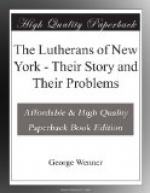In view of this statement it would seem to be a legitimate inference that even in the straitest sect of Lutherans in America the ultimate doctrine of Lutheranism, reduced to a single word, is grace.
Churches, however, have their distinguishing marks. In the Lutheran Church these are more difficult to find because of her catholic origin and spirit. While forms and ceremonies are retained, they play only a minor part in the expression of her churchliness. Bishops and presbyters, robes and chasubles, liturgies and orders, “helps, governments and divers kinds of tongues,” in the providence of God all of these things have been “set in the church.” Lutherans in many lands make use of them. An inexperienced observer, taking note only of crucifixes and candles sometimes fails to distinguish between Lutherans and Catholics. Yet none of these heirlooms of our ancient family belong to the essential marks of the church. Their observance or non-observance has nothing to do with the substance of Lutheranism.
Lutheranism aimed at reformation and not at revolution.
Its initial purpose was to bring back the Church to
the common faith of Christendom. Hence the Lutheran
Confession is in its large outlines that of universal
Christendom. Nevertheless, it received a distinctive
trend from the problems of soteriology. The ancient
Church had developed the doctrines of God and of Christ.
A beginning, too, had been made in the doctrines of
sin and grace and the way of salvation. But the
development had been hindered by hierarchical traditionalism
and by the spirit of legalism. These were the
obstacles that stood in the way. The cry that
went up to God from the hearts of the people in the
days of the Reformation was “What must I do
to be saved?” This cry found a voice in the experience
of Luther himself. This is what drove him into
the monastery, and this was the underlying quest of
his life as a monk and as a teacher in the university,
through monasticism to get to heaven. It was only
when he had found Christ, and realized that his sins
had been taken away through the atoning work of the
Son of God, that he found peace. It is His person
and work upon which the doctrine of our Church primarily
rests.*
"Luther, when he
said that justification by faith was the article
of a standing or falling Church, stated the exact
truth. He meant to say, in the terms of the New
Testament, especially of Paul, that God in Christ
is the sole and sufficient Saviour. He affirmed
what was in him no abstract doctrine, but the most
concrete of all realities, Incarnated in the person
and passion of Jesus Christ, drawing from Him its eternal
and universal significance.”—Fairbairn,
“The Place of Christ in Modern Theology,”
page 159.
In the words of the Small Catechism, Luther still teaches our children this foundation doctrine of our Church:
“I believe that Jesus Christ, true God, begotten of the Father from eternity, and also true man, born of the Virgin Mary, is my Lord, who has redeemed me, a lost and condemned creature, secured and delivered me from all sins, from death and from the power of the devil; not with silver and gold, but with His holy and precious blood, and with His innocent sufferings and death, in order that I might be His, live under Him in His kingdom, and serve Him in everlasting righteousness, innocence and blessedness.”




